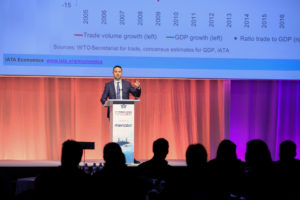WCS 2017: IATA expects global growth to ‘accelerate’
ABU DHABI, UAE — The global economy seems to be getting its groove back.
Despite weak world trade, IATA’s senior economist yesterday projected moderate acceleration in the global economy, with 2017 already off to a strong start in terms of air cargo volumes.
Speaking at IATA’s World Cargo Symposium in Abu Dhabi, George Anjaparidze said that the better performance of air cargo compared to world trade was explained by structural and cyclical factors in 2016 and this could be repeated in 2017.

On the structural side, sectors that rely on air cargo performed better than those that rely on maritime trade. Anjaparidze cited the example of the Eurozone, where broadening of growth has been a key factor in explaining the stronger demand for imports carried by air.
That had real implications for forwarders, carriers, and other stakeholders. In early 2017, IATA announced that European airlines posted a 7.6 percent annual increase in freight demand in 2016 and a capacity rise of 6.7 percent.
On the cyclical side, Anjaparidze noted that improving conditions in in emerging markets, led by China, had helped boost demand for air cargo in the third and fourth quarters. Another factor that boosted air cargo demand in the fourth quarter was the lagged positive impact from the Hanjin disruption, which led to a portion of the high value and time sensitive goods initially held up at sea to be served by air. “Air cargo also serves as a solution in times of disruption,” he said.
Overall, air cargo had a weak first quarter but recovered and grew in 2Q2016, continuing the upswing into the third and fourth quarters.
Yet, Anjaparidze noted that capacity in 2016 outstripped demand, in part due to continued delivery of new passenger widebodys, where payload belly capacity grew at 3.6 times that of freighter capacity in the same year. The capacity challenge is made worse by rising in-service freighter capacity – as older freighters have been brought out of storage as they become more economic to operate with fuel prices below their recent 2014 highs.
All things considered, IATA’s economic projection for growth in the industry is one of cautious optimism, with “risks tilting to the upside.” This projection is substantiated by a strong US economy, resilient underlying drivers of air cargo, such as strong export orders and rising consumer confidence.
Glyn Hughes, IATA’s global head of cargo, took the stage yesterday, as well, to present the year 2016 in review, during which air cargo decisively improved its performance, outpacing global growth.
Hughes listed several key IATA developments, starting with cargo safety. IATA made safe transportation of volatile batteries a major platform over the year, engaging with partners and pressuring governments to enforce safety standards. Lack of regulation and enforcement in the lithium-ion battery supply chain poses serious security threats, IATA warned in a letter to Ministers of Trade, Industry and Transport, and Directors of Civil Aviation of the world’s largest lithium battery manufacturing and export countries.

Another important development Hughes highlighted was an IATA announcement in mid-2016 that it had joined forces with freight forwarding advocacy group FIATA to “review, refine, and reengineer the current Cargo Agency Program to develop a new and modernized Program – IATA-FIATA Air Cargo Program (IFACP).” Hughes noted that this cooperation was aimed at developing customer centric relationships — “it’s about bringing in the regions,” he said.
IATA also advocated for the safe integration of drones and calling for regulatory alignment. The organization has worked to identify opportunities on the cargo side, such as last-mile deliveries.
“We need to come up with a program where they can safely integrate,” Hughes said.
At 48.5 percent e-AWB compliance, Hughes admitted that “the job is not quite half done.” However, he noted that that percentage adds up to 640,000 shipments per month. He called for stakeholders to work towards this year’s goal of 62 percent, pointing to the Middle East where penetration is at 74.3 percent.
“This is the example we will take on the road,” Hughes said
Those interested in learning more about airfreight in 2017, should join us at Cargo Facts Asia in Shanghai, 25 – 26 April. To register, or for more information, go to CargoFactsAsia.com





